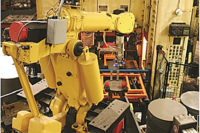Automotive manufacturers worldwide have looked to EFS Gesellschaft für Hebe- und Handhabungstechnik mbH for automated handling devices since 1996. Recently, EFS developed an electric, partially automated system for several German carmakers to help their workers more easily move doors during assembly.
Traditionally, such systems have been pneumatic. EFS customers’ concern about efficient resource use and future-production flexibility, however, convinced EFS of the need to provide them with an electric system capable of digital process sequencing.
“The requirement to accommodate variants and vehicles in the plants that are not yet known is increasing,” says Aaron Geenen, head of development at EFS. “It is important for us that the customer can set up, implement and adapt our system to changing vehicle doors.”
The new handling system incorporates several LKE clamping units, which are mounted on a linear guide. Made by the Zimmer Group, the units absorb high forces and output safety-related digital signals to verify status (open or closed).
Clamping kinematics are provided by an eccentric shaft with mechanical self-locking. This feature maintains full holding force in the closed state, and ensures exact door position, even if the power drops or the system is switched off.
According to Geenen, EFS intentionally developed a partially automated system to enable a “skills-based division of tasks” by the operator at the workstation. Other advantages are fewer adjustment processes and relatively lower operating costs.
System operation begins with the LKE unit element lifting the door out of a frame and holding it aloft in a safe position. Because all degrees of freedom are allowed in this position, the operator can easily perform each step in the assembly process.
A system touchpad lets the operator quickly call up each step, as well as accordingly adjust the up and down position of the door, and other process parameters, as needed. These parameters are stored in the control system for later reference. After completing assembly, the operator uses an XY rail or a handling system to transport the door to a nearby vehicle and install it.
“The fact that the [clamping units] can be easily controlled via digital signals is a great advantage of our new system,” says Geenen. “Also, transmitting system status via simple communication interface increases safety.”
Clamping forces of the unit vary from 600 to 1,800 newtons. The unit features a profile rail guide, a nickel-plated steel housing and a sliding block for floating bearings. A clamping jaw and integrated electronics are standard, with the unit using 24-volt power to open and close. An eccentric gear transmits power between the motor and clamping jaw.
Zimmer offers more than 4,000 products, including clamping and braking elements for linear rails, industrial shock absorbers, profile dampers, machine tools, five axis heads, motor spindles and custom assemblies. For more information, call 828-855-9722 or visit www.zimmer-group.com/en-us/.







